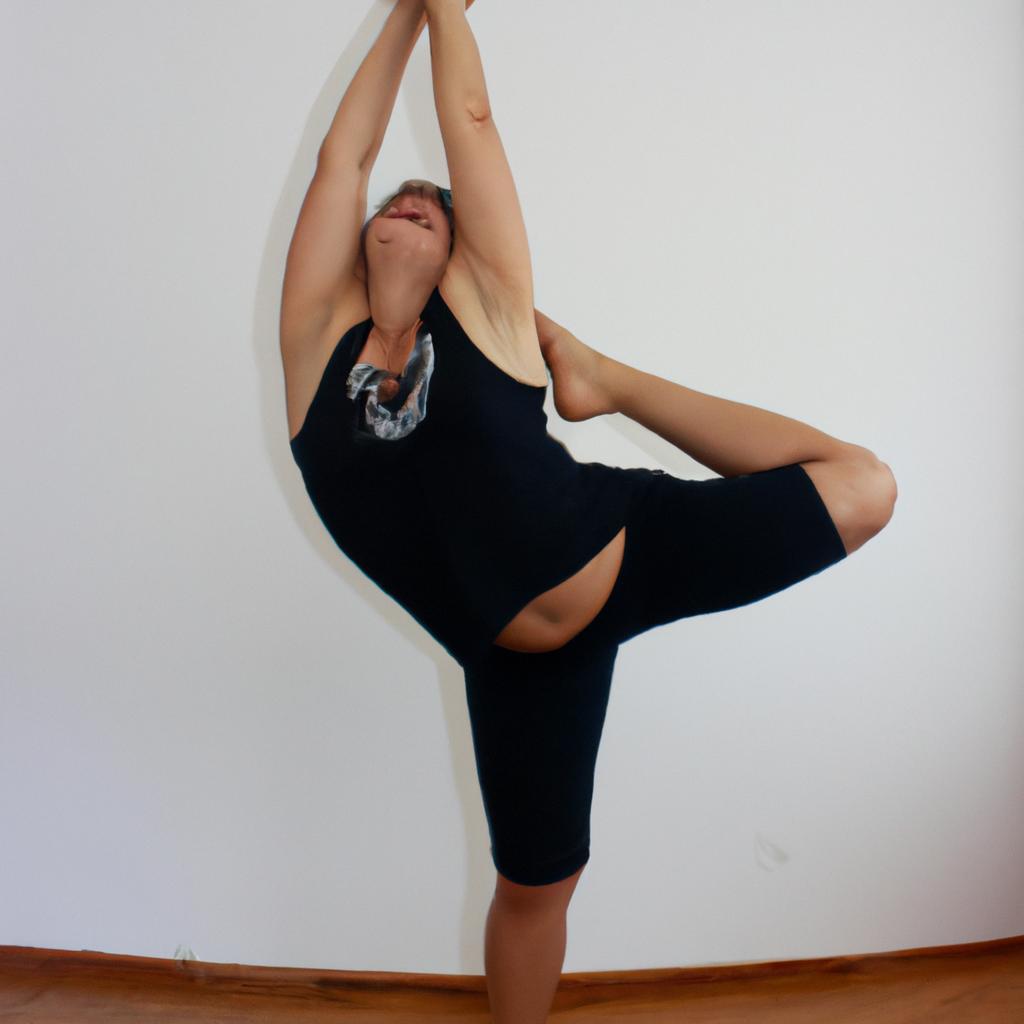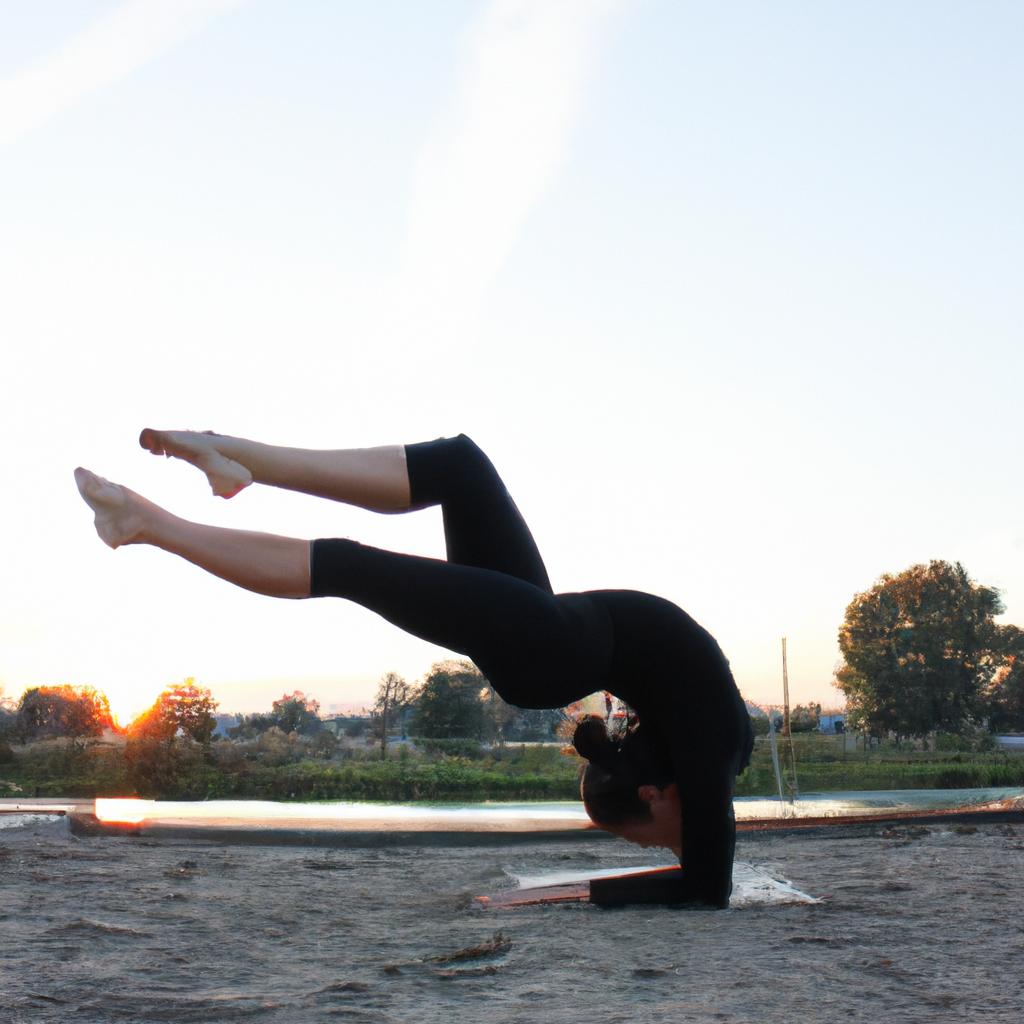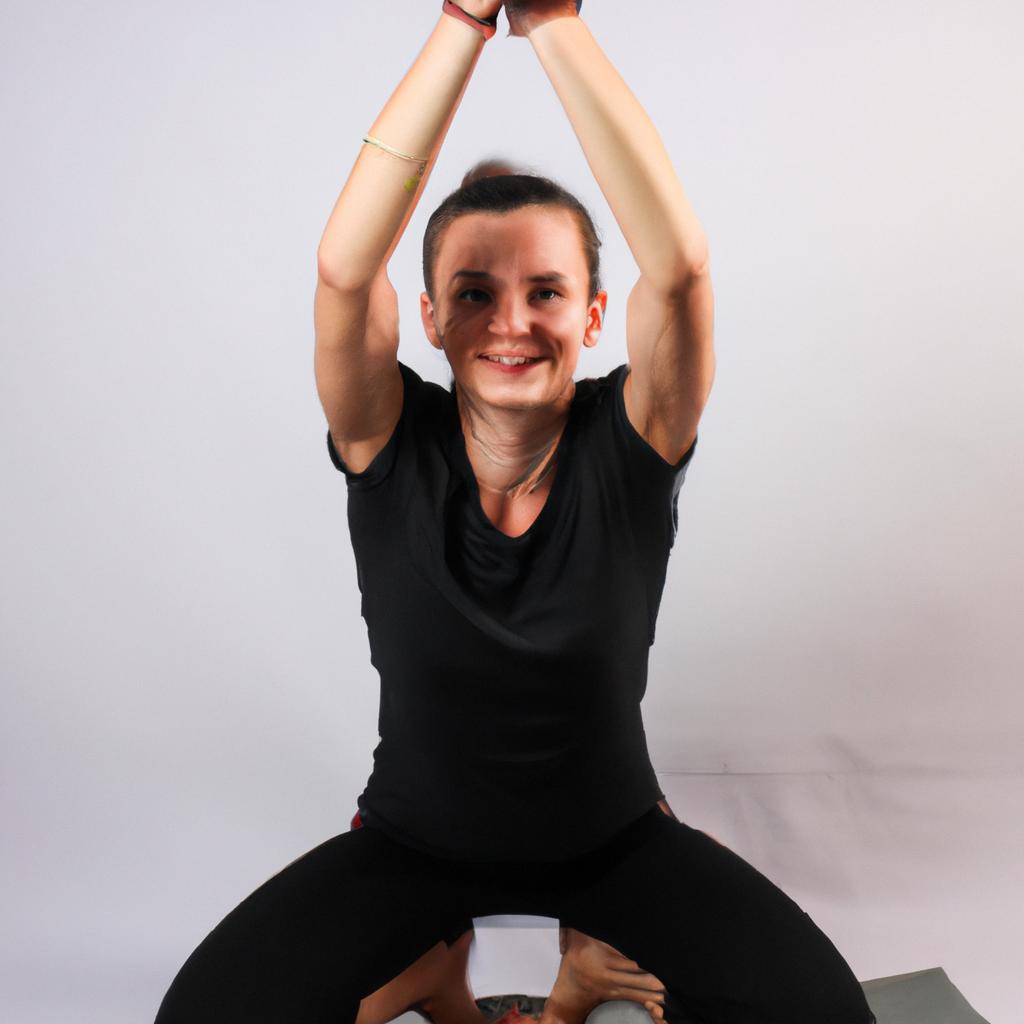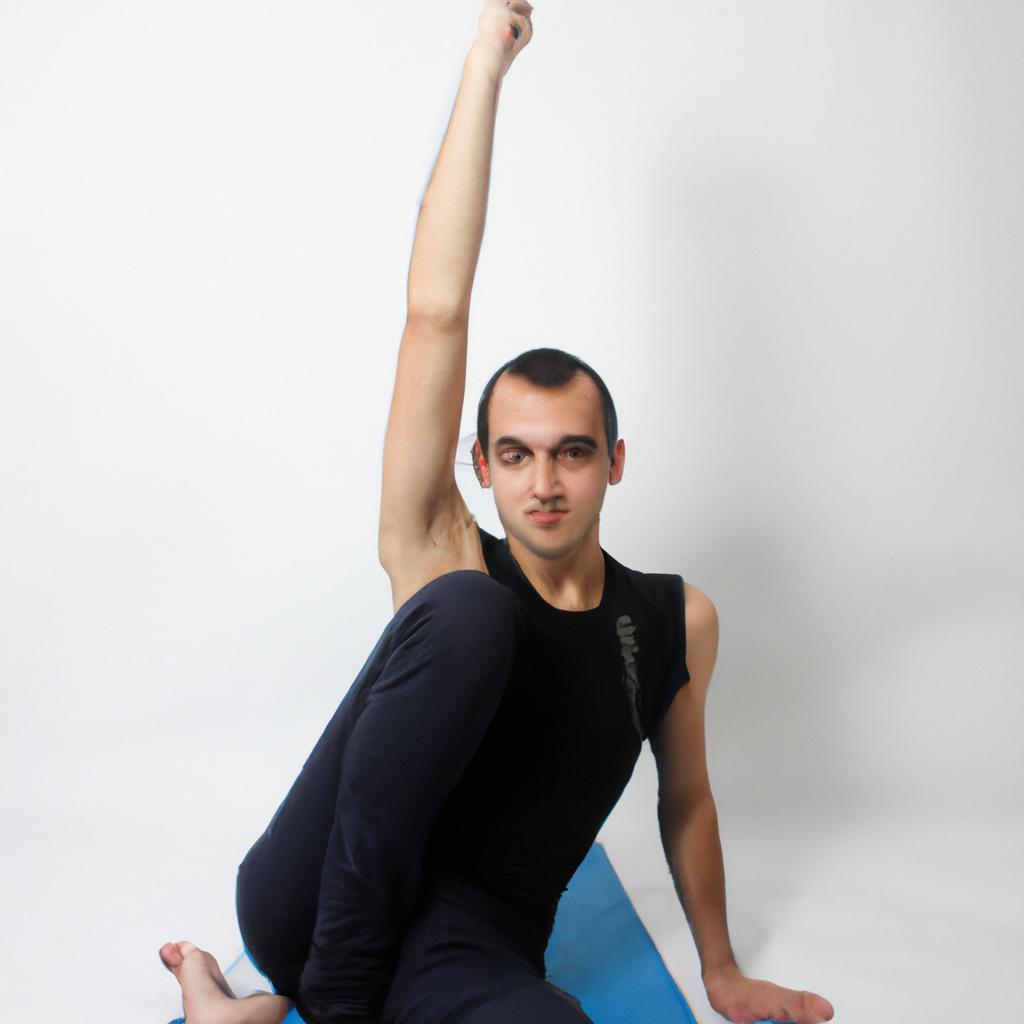Yoga has become a popular form of exercise and relaxation for individuals seeking to improve their physical fitness and mental well-being. Whether you are a beginner or have experience in other forms of fitness, embarking on a yoga journey can be both exciting and overwhelming. This article aims to provide a comprehensive guide for beginners looking to explore the world of yoga by focusing on fitness studios as an ideal starting point.
For instance, consider the hypothetical case study of Sarah, a sedentary office worker who spends long hours sitting at her desk. Feeling sluggish and lacking energy, she decides to incorporate yoga into her daily routine with the goal of improving flexibility, strength, and overall well-being. However, being new to yoga, Sarah is unsure about where to begin and how to choose the right fitness studio that caters specifically to beginners like herself. Through this article’s exploration of various aspects related to finding the perfect yoga studio for beginners, individuals like Sarah will gain valuable insights and guidance necessary for initiating their own transformative journeys within the realm of yoga.
Benefits of starting a yoga practice
Benefits of Starting a Yoga Practice
Imagine a busy executive named Sarah who constantly feels stressed and struggles to find balance in her life. She often finds herself overwhelmed with work, experiencing frequent headaches and trouble sleeping at night. One day, she decides to give yoga a try after hearing about its potential benefits. Little did she know that this decision would have a profound impact on her physical and mental well-being.
Physical Benefits:
Engaging in regular yoga practice can bring numerous advantages to one’s overall health. Firstly, it enhances flexibility by stretching muscles and improving joint mobility. This increased range of motion allows individuals like Sarah to perform everyday activities with greater ease while reducing the risk of injury. Additionally, yoga helps build strength through various poses that target different muscle groups. Improved muscular strength not only leads to better posture but also protects against conditions such as back pain or arthritis.
Emotional Well-being:
Apart from physical benefits, practicing yoga has significant positive effects on emotional well-being. Research studies have shown that yoga reduces stress levels by activating the parasympathetic nervous system, leading to relaxation responses within the body. For instance:
- Decreased cortisol levels: Yoga practice lowers the production of stress hormone cortisol, thus decreasing anxiety.
- Enhanced mood: Regular participation in yoga sessions boosts serotonin levels in the brain, which contributes to improved feelings of happiness and contentment.
- Better sleep quality: Engaging in relaxing postures before bedtime promotes deeper sleep cycles and alleviates insomnia symptoms.
- Increased self-awareness: Through mindfulness techniques practiced during yoga classes, individuals develop a heightened sense of self-awareness and learn how to manage their emotions effectively.
Table – Emotional Benefits of Yoga:
| Benefit | Description |
|---|---|
| Reduced Stress | Lowered cortisol levels resulting in decreased anxiety |
| Improved Mood | Boosts serotonin levels contributing to enhanced happiness |
| Better Sleep | Promotes deeper sleep cycles and alleviates insomnia symptoms |
| Increased Awareness | Develops self-awareness and emotional management skills through mindfulness practices |
Understanding the wide-ranging benefits of starting a yoga practice, Sarah now embarks on her journey to find the right fitness studio that will guide her in achieving optimal physical and mental health. Let’s explore how she navigates this process.
Finding the right fitness studio for yoga
Imagine this scenario: Sarah, a beginner yogi, is excited to start her yoga journey but unsure where to begin. She understands the benefits of yoga practice and wants to find a fitness studio that suits her needs and preferences. In this section, we will explore some key considerations when it comes to finding the right fitness studio for yoga.
Firstly, location plays an important role in choosing a fitness studio. Sarah lives in a bustling city with numerous options available. She decides to prioritize convenience by selecting a studio close to her home or workplace. This ensures she can easily attend classes without facing transportation challenges or wasting too much time commuting.
Secondly, facilities and amenities are crucial factors to assess while searching for a suitable fitness studio. Sarah prefers studios that provide clean and well-maintained spaces equipped with necessary props such as mats, blocks, and straps. Additionally, having adequate changing rooms and shower facilities enhances her overall experience before and after each session.
Furthermore, the qualifications and expertise of instructors greatly influence the quality of instruction received during yoga classes. Sarah values highly trained teachers who possess certifications from reputable organizations like Yoga Alliance. These certified instructors not only demonstrate deep knowledge about various yoga practices but also ensure proper alignment and safety throughout the sessions.
To further guide individuals like Sarah in making informed decisions about fitness studios for yoga practice, consider these emotional aspects:
- Community: A welcoming environment where practitioners feel supported.
- Variety: Diverse class offerings catering to different levels and interests.
- Ambiance: Studios that create a peaceful atmosphere conducive to relaxation.
- Flexibility: Class schedules that accommodate busy lifestyles.
Below is an example table highlighting different features offered by distinct fitness studios:
| Features | Studio A | Studio B | Studio C |
|---|---|---|---|
| Location | Convenient | Central | Suburban |
| Facilities | Well-maintained | Modern | Spacious |
| Instructors | Experienced | Knowledgeable | Passionate |
In summary, finding the right fitness studio for yoga involves considering factors such as location, facilities, and instructors’ qualifications. Additionally, emotional aspects like community support, class variety, ambiance, and flexibility also play a significant role in enhancing one’s overall yoga experience. With these considerations in mind, Sarah can now begin her search for the ideal fitness studio to embark on her yoga journey.
Now that we have discussed the key considerations when it comes to finding a suitable fitness studio, let us delve into choosing the appropriate yoga style that aligns with individual preferences and goals.
Choosing the appropriate yoga style
Having understood the importance of finding the right fitness studio for yoga, let us now delve into the crucial aspect of choosing an appropriate yoga style. By exploring different styles, you can identify which one aligns best with your goals and preferences.
Choosing the Appropriate Yoga Style:
To illustrate this point, let’s consider a hypothetical example: Sarah is a beginner who wants to improve her flexibility and reduce stress through yoga. She visits two fitness studios that offer different styles of yoga – Studio A specializes in Hatha Yoga while Studio B focuses on Vinyasa Yoga.
When deciding between various yoga styles, there are several factors to consider:
-
Intensity Level: Different styles vary in their intensity levels. For instance, Power Yoga tends to be more physically demanding compared to Yin Yoga, which involves holding poses for longer durations. Consider your current fitness level and desired level of challenge when selecting a style.
-
Focus and Benefits: Each type of yoga has its own unique focus and benefits. Ashtanga Yoga emphasizes strength-building and endurance, whereas Restorative Yoga promotes relaxation and healing. Reflect on what aspects you want to prioritize in your practice to find a suitable style.
-
Instructor Expertise: Research about the qualifications and experience of instructors at different studios offering specific yoga styles. Look for teachers who have relevant certifications or training in the style you are interested in pursuing.
-
Personal Preference: Ultimately, choose a style that resonates with your personal inclinations and interests. Experimenting with various styles during trial classes can help you determine which approach feels most enjoyable and fulfilling for you.
Consider these elements as guiding principles when making your decision about the most appropriate yoga style to pursue.
| Styles | Intensity Level | Focus & Benefits |
|---|---|---|
| Hatha | Gentle | Balance & Flexibility |
| Vinyasa | Moderate | Flow & Cardio |
| Bikram | High | Detoxification & Sweat |
| Kundalini | Varied | Spiritual Awakening |
In conclusion, choosing the appropriate yoga style is crucial to tailor your practice according to your needs and preferences. By considering factors such as intensity level, focus and benefits, instructor expertise, and personal preference, you can make an informed decision that enhances your overall yoga experience.
Now that we have explored the various yoga styles available, let’s move on to understanding the essential equipment for yoga beginners.
Essential equipment for yoga beginners
After considering the appropriate yoga style that suits your needs and preferences, it is important to ensure you have the essential equipment necessary for a successful yoga practice.
Having the right equipment can greatly enhance your experience as a beginner in yoga. Here’s an example to illustrate its importance: Imagine trying to balance on one leg without a proper yoga mat; not only would this be uncomfortable but also potentially dangerous due to lack of stability. Therefore, investing in the following equipment will help you create a safe and enjoyable environment for your practice:
- A high-quality yoga mat: This provides cushioning and grip while performing various poses, ensuring comfort and stability.
- Comfortable clothing: Opt for breathable fabrics that allow freedom of movement during different sequences.
- Supportive props: Items like blocks, straps, and blankets can assist beginners by providing support or modifying poses until flexibility improves.
- Water bottle: Staying hydrated throughout your session is crucial to maintain energy levels.
To highlight the significance of having the right equipment as a beginner, consider the following table showcasing how each item contributes to a positive experience:
| Equipment | Benefit |
|---|---|
| Yoga Mat | Enhances stability and prevents slipping |
| Comfortable Clothing | Allows unrestricted movement |
| Supportive Props | Assists with modifications and supports flexibility |
| Water Bottle | Ensures hydration throughout the session |
Equipped with these essentials, you are now ready to embark on your journey towards mastering yoga techniques. As you prepare mentally and physically for your first class, remember that choosing suitable attire and gathering all necessary items beforehand will contribute positively to your overall experience.
Transition into next section about “Preparing mentally and physically for your first class”: With all the required gear in place, it’s time to shift our focus towards preparing ourselves holistically – both mentally and physically – before attending our initial yoga session.
Preparing mentally and physically for your first class
Building on the importance of having essential equipment for yoga beginners, let us now delve into the crucial aspect of preparing mentally and physically for your first class. Understanding how to approach this new experience can help ease any anxieties you may have, allowing you to fully embrace the benefits that yoga has to offer.
Preparing mentally involves adopting a positive mindset and cultivating an open attitude towards learning. Consider Sarah’s case study – she was initially apprehensive about trying yoga due to her lack of flexibility. However, by reframing her perspective and focusing on personal growth rather than comparison with others, she soon found herself enjoying the practice and noticing improvements in both her physical and mental well-being.
To better prepare yourself mentally and physically, here are some key considerations:
- Take time before each session to set intentions or goals for your practice.
- Practice deep breathing exercises or meditation techniques to calm the mind.
- Stay hydrated throughout the day leading up to your class.
- Dress comfortably in breathable clothing that allows freedom of movement.
In addition to these mental preparations, it is also important to be aware of how your body feels before engaging in any physical activity. Listen attentively to its needs and modify poses as necessary. By doing so, you minimize the risk of injury while maximizing the benefits of each pose.
Markdown table:
| Aspect | Importance | Benefits | Example |
|---|---|---|---|
| Warm-up | Essential for preventing injuries | Loosens muscles, enhances blood flow | Gentle stretching exercises |
| Proper alignment | Crucial for maintaining balance and stability | Reduces strain on joints; improves posture | Aligning shoulders over wrists in plank pose |
| Controlled breathing | Fundamental for focus and relaxation | Increases oxygen intake; calms nervous system | Deep inhales through nose; slow exhales through mouth |
| Mindful movement | Encourages mind-body connection | Enhances body awareness and coordination | Engaging core muscles during standing poses |
By mentally preparing yourself and paying attention to your body’s needs, you can approach your first yoga class with confidence. However, it is important to be aware of common mistakes that beginners often make in order to avoid them. Let us explore these pitfalls further in the upcoming section on “Common mistakes to avoid as a beginner.”
Common mistakes to avoid as a beginner
Transitioning from preparing mentally and physically for your first yoga class, it is important to be aware of common mistakes that beginners often make. One such mistake can be pushing yourself too hard in the beginning stages of practicing yoga. Let’s consider an example where a beginner, Sarah, decides to attend her first hot yoga class and tries to perform advanced poses without properly understanding the foundations.
To avoid potential injuries or setbacks, here are some key points to keep in mind:
-
Respect Your Body:
- Listen to your body’s limits and take breaks when needed.
- Be mindful of any pain or discomfort during certain poses.
- Remember that progress takes time; don’t rush into difficult postures right away.
-
Focus on Alignment:
- Pay attention to proper alignment in each pose.
- Engage core muscles to support your posture and prevent strain.
- Seek guidance from instructors if you’re unsure about correct form.
-
Practice Regularly but Mindfully:
- Consistency is essential for improvement, so try to establish a regular practice schedule.
- However, avoid overexertion by allowing yourself rest days between sessions.
-
Embrace Patience and Acceptance:
Column 1 Column 2 Column 3 Progress may not always be linear Every individual has unique strengths and limitations It’s okay to modify poses based on your abilities Comparing yourself with others isn’t helpful Celebrate small victories along the way Trust the process and enjoy the journey
In conclusion,
By being mindful of these common mistakes and following these guidelines, you can enhance your experience as a beginner yogi. Remember that everyone progresses at their own pace, and it’s important to listen to your body throughout the journey. So take a deep breath, relax, and embrace the learning process with patience and acceptance. Happy practicing!




